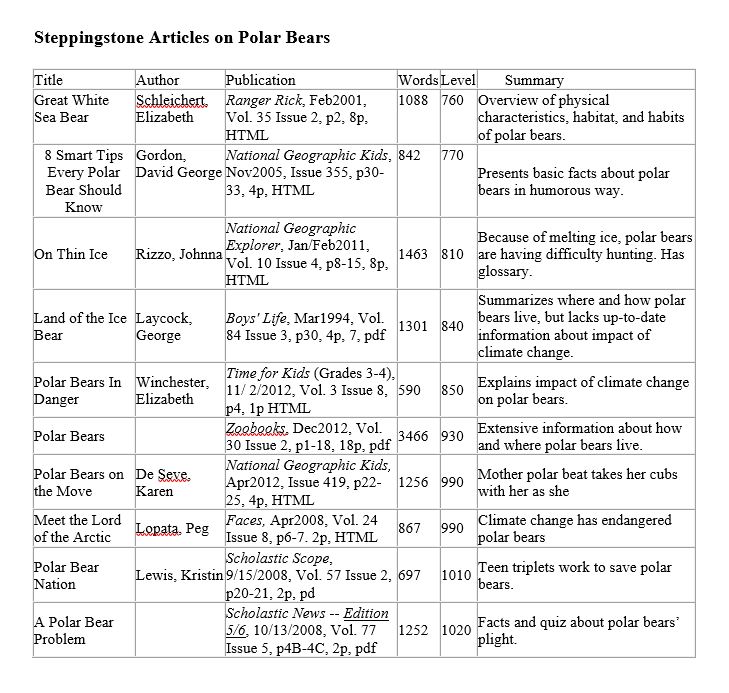Materials make a difference.
Students make the most progress when the materials they read are interesting and on the right level of challenge, which is usually the level where students can recognize 95 to 98% of the words. Students also work a bit harder when they have some say in the selection of materials.
Materials for Beginning Readers
The key task for beginning readers is mastering the code, which consists of phonics, syllabic analysis, and othr foundational skills. Instruction works best when the books and articles that children read reinforce the skills they have been taught. It is essential that there be a match between the skills students have acquired and the skills incorporated in the texts that they read. After learning the –ake pattern, students might read the The Cake that Mack Ate (Robart, 1986). Sheep in a Jeep (Shaw, 1986) would be a good choice for reinforcing the –eep pattern. Articles from children’s periodicals can also be used to reinforce decoding skills. “Shh . . . The animals are sleeping!,” an article from Scholastic’s My Big World, can be used to reinforce the –eep pattern.
This is a three-step process. First of all this requires having a awareness of the scope and sequence of basic decoding skills, knowing for instance that short-vowels are acquired before long vowels. The Phonics Readability Chart describes the key levels of phonics skills.
The second step is to find out what students’ ability to read basic phonics patterns is. The Phonics Inventory indicates students’ ability to read key phonics patterns.
The third step is to locate books that have been leveled according to the decoding skills needed to read them. The Decodability Index provides instruction for leveling texts in terms of the skills needed to read them, so that you can assess and acquire materials on the appropriate decodability level. However, in a list entitled “Books Leveled by the Decodability Index,” a number of children’s books have been leveled according to the skills needed to read them. Most of the books listed are children’s books that just happen to reinforce certain phonics. They weren’t created to be decodable texts. As a result, their content is more engaging and their language more natural.
All Readers
Children’s Periodicals
Children’s periodicals add variety to the literacy curriculum. In general, they are also written in a lively, engaging style and offer support in the form of photos, explanatory maps and charts, phonetic respellings of words, and definitions of key terms. Best of all, many libraries offer free access to periodicals. Click here for a listing of major children’s periodicals. Click here for a listing of a range of articles from children’s periodicals.
A number of states and many local and school libraries subscribe to databases of articles from children’s’ periodical, such as Ranger Rick, National Geographic, Scholastic magazines, Time for Kids, and Sports Illustrated for Kids. Periodical articles are accompanied by Lexile levels so the teacher can provide students with materials on their reading level. Databases are listed below.
EBSCOhost (Ebsco) (K-12)
Grolier Online (GO) (Scholastic)
eLibrary® Elementary (ProQuest- K-6)
eLibrary (ProQuest) 4-12
InfoTrac (Cengage Gale): Student (secondary),
Junior (middle & jr high), Kids (elementary)
Kids InfoBits (Cengage Gale) K-5
SIRS Discoverer (ProQuest) 1-8
Websites
Websites are an outstanding source of reading material, but they vary in quality and readability. Click here for an annotated bibliography of selected websites and their estimated readability levels.
Easy Informational Books
Living as we do in a golden age of informational books, there is an almost unlimited supply of books on almost every subject imaginable. However, informational books tend to be on or above grade level. Click here for an annotated bibliography that describes and provides estimated reading levels for informational books that are of high quality but are on the easy side.
A Steppingstone Approach
One research-based method for boosting students’ ability to read challenging informational text is to use a steppingstone approach. In a steppingstone approach, students read texts that gradually increase in difficulty. The texts are on the same topic so that as students read increasingly difficult texts they grow in reading ability. The easier texts build a base for reading the more complex ones by developing background and vocabulary. As implemented in the research-based Interactive Strategies Extended approach, the teacher might select a grade-level biography of John F. Kennedy and then locate four of five biographies written on easier but gradually increasing levels (Gelzheiser, Scanlon, Hallgren-Flynn, & Connors, 2019). With support from the teacher, the student reads these increasingly difficult biographies and, if all goes well, is able to handle the grade-level biography. (Students who need it are also provided with intensive instruction in word recognition skills).
Steppingstone books can be obtained through your school or local library. Some sources for identifying suitable books are Titlewave, Renaissance Learning’s Bookfind, and Metametrics (Lexile framework). Titlewave is a commercial site used by librarians to purchase books. Books can be searched by title, author, subject, maturity level, or readability level. Many of the books listed on Titlewave are also accompanied by reviews. Metametrics lists close to 150,00 books that can be searched. Using the Lexile search feature, Find a Book, 34 books on Kennedy were listed with Lexiles ranging from 440 to 1580. Book distributors, such as Amazon and Barnes and Noble, can also be used. Many of the books on Amazon, Titlewave, and other sites have a look-inside feature that allows readers to examine sample pages. Periodical articles can also be used in a steppingstone approach. Here is a listing of articles on polar bears arranged by Lexile levels:
Note: PDF versions are exact copies of the original articles and so contain all illustrations. HTML versions generally contain only print.
Source: Gunning, T. (2020). Reading and responding to complex informational text. Unionville, CT: Galvin Publishing. Reprinted by permission.
